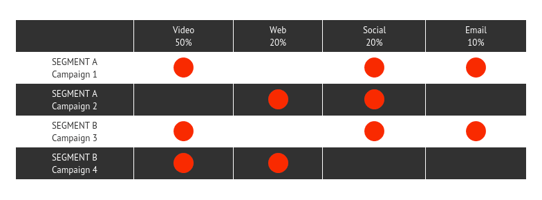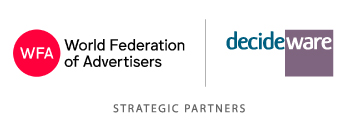The ANA has just released the June issue of FORWARD, and included is a cutting-edge...
Scope of Work: The Right Team on the Right Business
Aligning marketing, agencies and procurement through better Scope of Work management
1. Why is the Scope of Work process so important?
As with other professional services categories the Scope of Work process is becoming ever more important in managing marketing spend. A well-controlled Scope of Work program is an integral part of a robust framework for planning and communication between client and agency.

Re-published 3 April 2020
1. Why is the Scope of Work process so important?
As with other professional services categories the Scope of Work process is becoming ever more important in managing marketing spend. A well-controlled Scope of Work program is an integral part of a robust framework for planning and communication between client and agency.
The Scope of Work / Scope of Service process (referred to generically as SOW in this document) generates a wide range of benefits.
• It allows the client to accurately define the expected outcomes, service and work that are to be performed. And, just as importantly, it articulates what work will not be performed.
• This provides the agency with a clear way in which to review the projected workload and priorities. The agency can use this to suggest the appropriate resources that should be applied to fulfill the work.
• Finally it provides procurement and finance departments a lens with which to view the fees in a balanced and appropriate manner.
2. Optimizing Spend
The key outputs of the agency are driven by talented and creative people applying their skills to produce deliverables across a range of initiatives and projects. But with all the current discussion on how the agency should be paid, it is easy to lose sight of why the agency is being paid and for what. Indeed by viewing your SOW program as a core strategic driver in your marketing organization, centralizing, standardizing and streamlining the processes around it will provide dramatic improvements in both supply management efficiency and marketing effectiveness.
One of the clearest messages heard from leading advertisers is that the objective for a better SOW and compensation process is not to reduce the actual amount of money that is going out the door. Indeed for most enterprises, marketing spend is seen as an investment in growth rather than a cost center. So the primary driver is normally to ensure optimal spend of the allotted budget.
“I want to make sure that the right team is working on the right business at the right time”.
In this message there are two aspects to consider.
• Firstly defining what the right business and right time are—this is the responsibility of the client.
• Secondly defining the right team—this is the responsibility of the agency.
For new business, a well-defined SOW makes sure that an agency that has just won a new account keeps appropriate focus after the pitch process.
“This is one of the biggest stumbling blocks in contractual relationships. The service providers nominate the cream of their resources (The A Team) in their offers, and when the relationship is formed, the B Team walks in!”
Another common misconception around the “right team” is that this means the agency needs to apply its most experienced (and most expensive) resources to every part of the client’s business.
3. The basic building blocks
Although there is a wide variation in client SOW’s, there are some common building blocks that appear in many programs (though the terminology and order may vary).
• It generally starts with a discussion around the marketing goals and objectives (Outcomes)
• It then moves to defining the set of services, including expectations, roles and responsibilities. This includes any specific initiatives or projects that have been identified (Scope of Service)
• It describes the concrete deliverables or outputs that are needed to fulfill the outcomes sought (Scope of Work)
• The agency generally responds with the expected resources that will be needed to meet the entire SOW (Resource Plan)
• In conjunction with a Master Service agreement, it specifies a framework for how compensation will take place (e.g. labor, deliverables, commission) and allows the agency to respond with the actual fees
(Fee Summary)

Some learnings from other service-based SOW processes (e.g. IT and construction) are to review carefully the assumptions that have been made as well, as the constraints under which the agency will need to work. In terms of constraints this is especially true of budget, and we are all aware of the waste of time that can occur when an SOW is drafted which clearly will not have budget to support it.
One key piece of advice is to ensure that it is explicitly noted in the Scope of Service who has responsibility for each element; agency, client or 3rd party. This is increasingly important as multiple agency types collaborate on campaigns.
Service expectations and timing should also be clearly identified. The priority, projected timelines and expected response levels all affect the agency’s resource load and should be factored into the SOW.
4. A clear and consistent framework
Looking deeper at the actual Scope of Service and Scope of Work elements, one aspect found in good SOW programs is consistency of terminology. A suggestion is to sit down as a team and clearly articulate a “dictionary” of terms for your organization. Here you are seeking to break down the overall SOW into manageable and consistent building blocks. This allows new people to more quickly understand the components and to learn the language of the organization.
Defined list of services
As an example, create a defined list of services that your company sources from its agencies. Rather than allowing free-format definitions of what is to be purchased, ensure that users pick from a list of pre-defined agency services. This acts as a reminder to the marketer, ensuring that all aspects of the marketing mix are reviewed when defining what they are seeking.
Master list of deliverables
Similarly create a master list of deliverables that your agencies either currently produce or anticipate producing on your behalf. Over time you should be able to build a database of the actual deliverables produced by each agency and track the approximate cost of those deliverables by type. For those interested in shifting from a labor-based compensation methodology to one that incorporates more output-based fees this will prove invaluable.
Other considerations
Ideas from other leading SOW programs are to standardize the phases of work (e.g. Strategy, Ideation, Execution etc) while others categorize the expected complexity for each part of the process. This should be considered in both the creative and media related fields. Certainly definitions of markets (regions or countries) and customer segments / audiences should be consolidated.
A comprehensive list of services from the 4A’s & ANA compensation guide is;
• Strategic planning
• Market research
• Creative development and execution for all (or selected) media and non-media venues
• Production, casting/talent, licensing, traffic, and art buying
• Media planning, research, and buying
• Internet/interactive, search, and Web site (e.g., strategy, design, or programming)
• Public relations and public affairs
• Database, direct marketing, and customer relationship management
• Sales and in-store promotions, channel marketing, and sponsorships
- Experiential marketing, events, trade shows, and exhibits
5. Resource Visibility & Variability
Most rational clients understand that if they want the “A” team then they have to pay for it!
Reviewing the Resource Mix
In order to optimize budget spend the SOW should clearly articulate which aspects are highly strategic in nature and thus need a “heavy firepower” agency team to be deployed on that work. Similarly they should also identify those that are lower priority and probably more tactical. Again this allows an appropriate resource mix to be applied.
From a centralized agency management perspective (be it procurement, operations or marketing led) it is vital that the SOW program allows you instant visibility in each Scope of Work to compare the priority and resource mix. Indeed the ability to compare the resource mix across various SOWs provides a great way to benchmark agencies (rather than simply focusing on the fees). This line of sight, from priority to resource mix to fee, provides the agency management practitioner with a balanced way to review each SOW. It also makes suggestions to both the marketers and agency about how to achieve better outcomes, without affecting the actual top line budget figure.
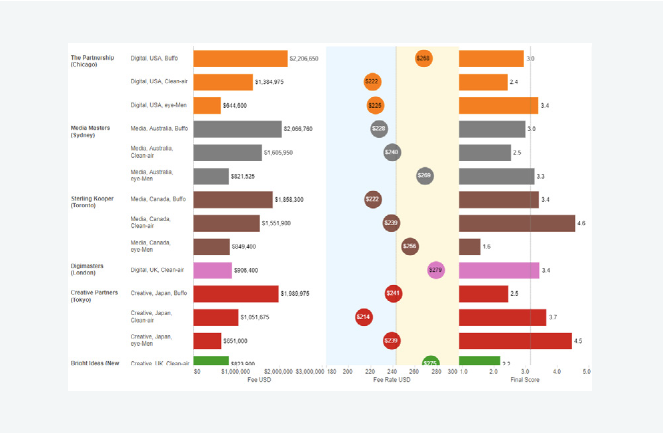
Getting the best out of the Resource Plan
Many resource plans are based around a Full Time Equivalent (FTE) model. In some the resources are named, while in others simply the type of resource is provided. Of course there are complex SOW’s which contain a mix of these two.
There are two elements that the agency should provide in its resource plan for each FTE; the department and their role. The 4A’s has a very well constructed model for these two that it uses as part of its agency benchmarking survey, and it is strongly recommended.
It is also vital that each resource line in the SOW be tagged with the definitions that the client uses for department and role tags (not what the agency calls it, though obviously this can also be stored). This is to ensure that in reviewing the resource mix, it is easy for the vendor management practitioner to recognize the experience, seniority and specialization of each resource. This allows them to quickly review that against the services and deliverables being requested. Because agencies may have completely different nomenclature for specific roles, if these are not standardized, it can be very difficult to interpret.
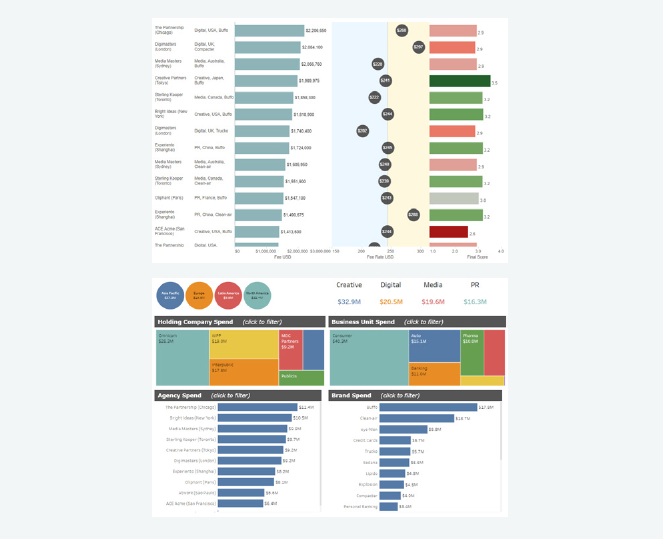
6. Fees: Cost and Value drivers
Probably the most contentious part of the SOW process is when it comes to extrapolating the fee and determining whether it is set at the correct level.
A range of influencing factors could be incorporated in any model that assists building or reviewing the fee component. They depend on the level of sophistication of the marketing procurement / agency supply management function. As well as the constraints around budget, there are two key dimensions that underpin the fee level.
What is the value of the output being delivered, and what is the cost to produce it?
Value drivers
From a value perspective we have already looked at the underlying strategic nature of the work being produced and its creative or media-related impact. Another key aspect in value is looking at it from a sourcing perspective - what is the uniqueness of the service being delivered and how does it fit into the competitive landscape? By this we mean, is the service unique, does it involve a high degree of IP transfer and is the impact of switching to a new provider high? On the other hand can this service be delivered by a wide range of competitors (at the same level of quality), does it have a fairly minimal IP component and is the impact of switching providers fairly low? Using a “Boston Matrix” approach the example below categorizes perceived value into 4 segments from low to high $ - $$$$
Cost drivers
From a cost basis as well as looking at the resource mix (in terms of both experience and skill level) it also helps to understand the complexity of the work that is being undertaken. How much re-work is expected? Is it projected that there will need to be exploration of new ideas? How much management will be needed and in reverse how strong are the processes on the client side to handle information transfer (briefing and approval).
One should be careful not to over-engineer the SOW process but at least the above points should be reviewed and some form of rigor applied to identifying these fee drivers. By adopting a balanced look at these two aspects, it allows marketing, procurement and the agency to discuss the fee in an appropriate manner.
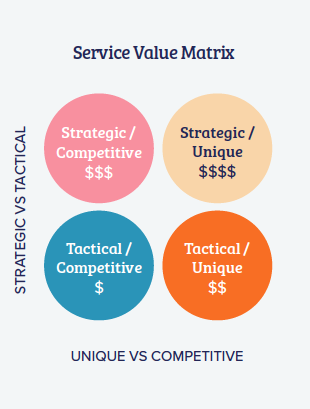
7. Summary
In breaking out the constituent parts of the Scope of Service / Scope of Work process and applying a disciplined, centralized approach there are benefits at every level.
It helps marketers to clearly articulate what they are looking for, provides the agency an accurate guide to which they can respond and finally provides procurement / finance with a clear picture of the cost and value drivers that underpin the fee component.
In providing a central process that helps the three parties make informed decisions it impacts on both the efficiency and effectiveness of the client agency relationship. In providing a communication bridge that drives the marketing work process it represents a lever in the marketing supply management chain that delivers tremendous return on investment.
8. Worth a Read!
Why the Right Scope of Work Is So Important ANA’s Resources – 2017 Richard Benyon
2019 Employee Compensation Report 2019 4A’s
With thanks to clients, agencies, partners and other contributors from the Decideware Blog, LinkedIn and requests for input. You know who you are and your contributions are invaluable.


